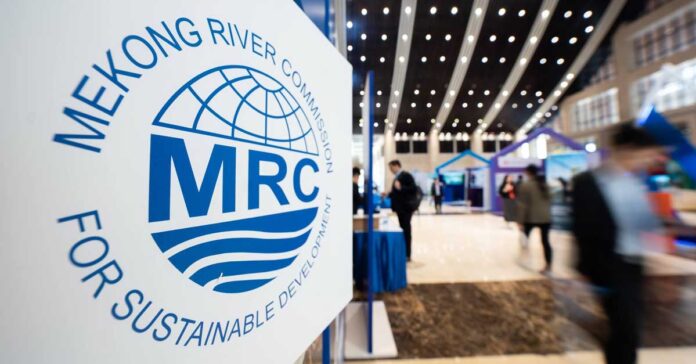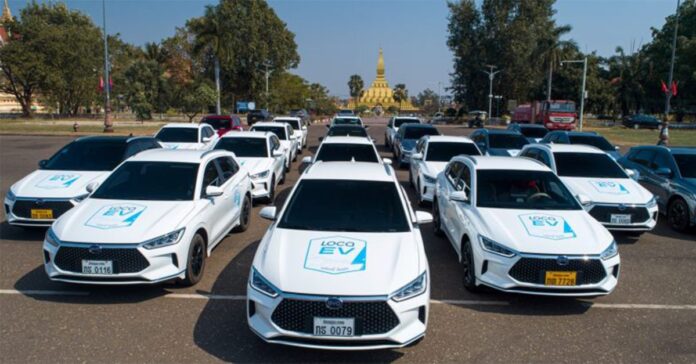On the heels of the historic UN Water Conference in New York, the Mekong River Commission (MRC) wrapped up its International Conference on Monday with a sense among participants that it is time to move past aspirational words, and focus on taking action that makes a meaningful difference.
Lao National Arrested in 40 Kg Meth Bust in Cambodia

Cambodian authorities have apprehended two drug traffickers who entered the country on 30 March, following a tip-off.
Laos Sees Marginal Relief From High Inflation, With 0.29% Decrease in March
According to the Lao Statistics Bureau (LSB), the total inflation rate for March decreased slightly to 40.97% compared to February’s figures of 41.3%.
Goodman Magic Mile Charity Run is back: Register now and support Habitat for Humanity to improve living conditions for vulnerable Hong Kong households
- Goodman announces the return of Goodman Magic Mile Charity Run at the all-new Goodman Westlink logistics facility in Tuen Mun on Sunday, 7 May 2023
- The event is open to the public and corporate sponsors
- Registration closes on 10 April 2023
HONG KONG SAR – Media OutReach – 5 April 2023 – Goodman is excited to announce the return of the Goodman Magic Mile Charity Run, which will take place on Sunday, 7 May 2023, at the brand new sustainable Goodman Westlink logistics facility in Tuen Mun. In partnership with Habitat for Humanity Hong Kong (‘Habitat’), the Goodman Magic Mile aims to raise funds for Habitat’s ‘Project Home Works’ program, which enhances the living conditions of vulnerable families, the elderly, and individuals with disabilities in Hong Kong.
Participants can choose from three races:
- Magic Mile Classic: A one-mile run or walk up Goodman Westlink’s cargo ramp which is open to everyone
- Magic Mile Challenge: A four-mile race requiring competitors to run four laps of the ramp
- Obstacle race: A family-friendly challenge for adult and child pairs that involves a 60-meter obstacle course over reusable and recycled items
“In Hong Kong,1.65 million people live below the poverty line and hundreds of thousands of people are living in unhealthy and cramped conditions,” Jo Hayes, Chief Executive Officer, Habitat for Humanity Hong Kong said. “We are honoured to partner with Goodman to raise awareness and funds through the Goodman Magic Mile Charity Run. We believe everyone deserves a decent place to live, so everyone who contributes to this meaningful cause plays a role in building hope, dignity and self-reliance in the community. We look forward to seeing everyone at the start line in May!”
Kristoffer Harvey, CEO of Goodman Group Greater China said: “After three years, it’s fantastic to be hosting the Goodman Magic Mile again – this time at our latest development, Goodman Westlink. All funds raised during the event will directly benefit Habitat’s ‘Project Home Works’ program and the people it supports to live healthier lives. We’re really happy with the response to date, and look forward to welcoming customers, corporate sponsors, colleagues, and their families back to this key community event in Hong Kong.”
Event details
| Date: | Sunday, 7 May 2023 |
| Time: | 8:30 am – 1:00 pm |
| Location: | Goodman Westlink, 8 Siu Lang Shui Road, Tuen Mun, Hong Kong (Visit the Goodman Westlink website to find out more about the event location) |
| Free shuttle bus service: | 1. Admiralty MTR Station Exit A (near Drake Street) to Goodman Westlink + Depart at 7:15 am and 8:15 am 2. Nam Cheong MTR Station Exit A (Sham Mong Road) to Goodman Westlink + Depart at 7:45 am and 8:45 am 3. Tuen Mun V-City G/F (Near shop G10) <> Goodman Westlink + From 8:00 am to 1:00 pm with a frequency of every 15 – 20 minutes (circular service) |
| Event site: | https://www.goodman.com/hk/goodman-magic-mile |
| Registration site: | https://hkmagicmile.goodman.com/ |
| Registration deadline: | Monday, 10 April 2023 |
Cost:
Individual and Team Registration
+ Classic team race (teams of four) – HK$1,000 per team
+ Challenge individual race – HK$300 per person
+ Obstacle race – HK$150 per pair
Corporate Platinum – HK$75,000
+ Classic team race for up to eight corporate teams (teams of four)
+ Challenge individual race for up to 20 entries
+ Obstacle race for up to six pairs (teams of two)
+ Home Improvement workshop by Habitat for up to six participants
+ Volunteering opportunity with Habitat for up to ten participants
+ Named as Platinum Sponsor in the event media
+ Company logo on main stage, website and all promotional materials
Corporate Gold – HK$50,000
+ Classic team race for up to five corporate teams (teams of four)
+ Challenge individual race for up to ten entries
+ Obstacle race for up to four pairs (teams of two)
+ Home Improvement workshop by Habitat for up to four participants
+ Volunteering opportunity with Habitat for up to five participants
+ Named as Gold Sponsor in all the event media
+ Company logo on main stage, website and all promotional materials
Corporate Event Partner – HK$10,000
+ Classic team race for up to one corporate team (teams of four)
+ Challenge individual race for up to two entries
+ Obstacle race for up to two pairs (teams of two)
+ Company logo on website and some promotional materials
Donation Only
+ If you cannot take part in the race, you can also show your generous support by donating to the cause.
Hashtag: #GoodmanGroup
The issuer is solely responsible for the content of this announcement.
About Goodman
Goodman Group is an integrated property group with operations throughout Australia, New Zealand, Asia, Europe, the United Kingdom, and the Americas. Goodman Group, comprised of the stapled entities Goodman Limited, Goodman Industrial Trust and Goodman Logistics (HK) Limited, is the largest industrial property group listed on the Australian Securities Exchange (ASX: GMG) and one of the largest listed specialist investment managers of industrial property and business space globally.
Goodman’s specialist global industrial property expertise, integrated own+develop+manage customer service offering and significant investment management platform, delivers essential infrastructure for the digital economy. Goodman helps create sustainable and innovative property solutions that meet the individual requirements of its customers, while seeking to deliver long-term returns for investors.
For more information visit: ![]() www.goodman.com
www.goodman.com
About the Goodman Foundation
The Goodman Foundation aims to improve the quality of life, standard of living and health of people across the communities where Goodman operates. Its focus is on social change and improving the lives of those living with disadvantage in our community by providing practical assistance by way of capital expenditure for equipment, funding of programs and projects, warehousing or office space or the expertise of our people. In addition to receiving a Foundation grant, many of our community partners, benefit from fundraising and volunteer support from Goodman employees in our good+heart program along with regular payroll donations through the Goodman good+deeds workplace giving program.
The Goodman Foundation is represented across Australia, New Zealand, Mainland China, Hong Kong, Japan, United Kingdom, Europe, USA and Brazil.
Through our strategic partnerships with charities, the Goodman Foundation is Building+Communities and making a meaningful difference to the lives of disadvantaged people and vulnerable communities.
For more information please visit ![]() www.goodman.com/foundation
www.goodman.com/foundation
About Habitat for Humanity Hong Kong
Driven by the vision that everyone deserves a decent place to live, Habitat for Humanity began in 1976 in the U.S. as a grassroots effort. The housing organisation has since grown to become a leading global non-profit working in more than 70 countries. Habitat works locally in Hong Kong and across the Asia and Pacific region, to help families achieve the strength, stability and self-reliance they need to build better lives for themselves. Financial assistance and volunteers from Hong Kong have contributed to Habitat supporting more than 46 million people globally. Through shelter, we empower. To find out more about our work, visit our website ![]() www.habitat.org.hk
www.habitat.org.hk
![]() https://twitter.com/Goodman_Group
https://twitter.com/Goodman_Group
![]() https://www.instagram.com/goodman.group/
https://www.instagram.com/goodman.group/
![]() https://www.linkedin.com/company/goodman?original_referer=
https://www.linkedin.com/company/goodman?original_referer=
![]() https://www.youtube.com/channel/UCqPJamGrRaP3OaT16gOCCeQ
https://www.youtube.com/channel/UCqPJamGrRaP3OaT16gOCCeQ
Financial PR (HK) Reaches a Strategic Alliance Agreement with Kerl & Cie To Jointly Expand Cross-board Financial PR Services
Under the Agreement, both parties will engage in extensive cooperation in areas such as cross-border investor roadshows, media promotion, digital communication, corporate training, event planning, and market analysis through resource sharing. Furthermore, they will leverage their influence in professional fields and regions to provide cross-border financial PR services to enterprises in the Asia-Pacific and European regions, while further expanding into new regions and markets.
Financial PR (HK) is a leading financial PR company in Hong Kong, specialising in providing high-quality and professional investor relations, public relations, and media promotion services for listed companies in the Asia-Pacific region. Meanwhile, Kerl & Cie, located in Frankfurt, Germany, has vast experience in public relations, advertising planning, and design, and possesses a robust business network in Europe. This strategic alliance marks a significant milestone for both parties to achieve a win-win cooperation. Both parties will pool their respective advantage to further strengthen their competitiveness, promote leapfrog development of both businesses, and bring new opportunities for development.
Mr. Hon Fung, Managing Director of Financial PR (HK), said, “We are thrilled to forge a strategic alliance with Kerl & Cie, which signifies not only our strategic collaboration in cross-border business expansion but also embodies the mutual trust and respect between both parties to attain win-win objectives through cooperation. At present, we have an extensive business network in the Greater China region and Singapore. This cross-regional cooperation allows us to broaden our international market presence and amplify our influence in the European region, leveraging Kerl & Cie’s strong resource network. We look forward to working closely together to deliver excellent results to our clients.” He added, “Going forward, we will continue to strengthen cooperation with leaders across various industries and regions, achieve complementary advantages, optimise resource allocation, and be committed to enhancing competitiveness while also bringing higher quality services to our clients.”
David Kerl, Managing Director Kerl & Cie, said: “We see great potential in this cooperation. As a leading PR company in the financial industry in Germany, we can add a real value for any Asian company that likes to communicate with the German public.”
The issuer is solely responsible for the content of this announcement.
About Financial PR (HK) Limited
Financial PR (HK) was established in June 2012 in Hong Kong and is an Asia-based comprehensive capital market professional service company. It combines investment relations, corporate promotion, financial media public relations and online media release services in one. Its holding company is Shanghai Shihua Information Technology Service Co., Ltd., mainly owned by BlueFocus Intelligent Communications Group Co., Ltd. (listed on the Shenzhen Stock Exchange, stock code: SZ.300058). Financial PR (HK) provides expert solutions for shareholders through flexible and innovative ideas that benefit both parties. Since 2013, they have contributed by organizing various investment conferences and awards annually, leveraging their professional knowledge and extensive networks to attract over a hundred companies and investors to exchange views on investment themes and strategies, becoming an effective and widely recognised communication platform in the Asian market.
About Kerl & Cie Gesellschaft für Kommunikationsberatung GmbH
Kerl & Cie creates tailored communication solutions for its clients and combines services from the areas of public relations, media planning and advertising. In addition to the information and media industry, their clients primarily include financial service providers such as banks, brokers, fund companies, derivatives issuers, stock exchanges and real estate companies. The range of services offered by Kerl & Cie covers the entire spectrum of communication and online and offline marketing.
LOFTER Group partnered with “The Hub Hong Kong”, a non-profit children’s charity
to hold a Easter fun day to celebrate with the grass-root children
HONG KONG SAR – Media Outreach – 4 April 2023 – LOFTER GROUP (“LOFTER” or “the Group”), a Hong Kong-based property developer has always been caring for people from different social strata and committed to giving back to the community. With the advent of Children’s Day and Easter, the Group, through LOFTER Care Community Programme, partnered with “The Hub Hong Kong”, the local non-profit making children’s organization, to organize a fun day to celebrate the festival with the children through making handicrafts and playing group games.
LOFTER Care Community Programme adheres to the spirit of “LOFTER Cares All”. The event co-organized with The Hub Hong Kong and the volunteers from different departments of the Group led the children to participate in handcrafting and group games, as well as giving them the small gifts to share a happy time. The Group also took this opportunity to express concern to them and understand their needs in life.
Ms. Carol Chow, Founder and Chairperson of LOFTER said, “Many children do not have an ideal living space and appropriate assistance to guide them on studying. We hope to increase their learning opportunities and give full play to their potential through different assistance. With the advent of Children’s Day and Easter in April, the Group hopes to celebrate with grass-root children on fun day, so that they can feel strong festive atmosphere and enjoy the good time together.”
Click here to download more HD photos.
Hashtag: #LOFTERGROUP
The issuer is solely responsible for the content of this announcement.
LOFTER GROUP
Founded in 2012, LOFTER GROUP is a property developer based in Hong Kong. It is principally engaged in developing exceptional and high-quality residential, commercial, retail, and industrial properties. Leverage on its extensive experience, the Group is actively exploring a variety of opportunities for developing urban renewal projects across core districts of Hong Kong, with key focus on Grade A Commercial and Luxury Residential Projects. The Group vows to accommodate the needs of a diverse market and dynamic social policies, while maintaining a good balance between profitability, responsibility and sustainability.
LOFTER-Care Community Program
LOFTER-Care Community Program is funded by LOFTER GROUP, sharing the value of “LOFTER Cares ALL”. It mainly provides support to charitable activities in HKSAR. The program strives to keep abreast of the needs of the community and flexibly provides various resources to the needy, aiming to bring positive changes to the world and build a sustainable future for the city.
The Hub Hong Kong
The Hub Hong Kong is a registered charity established in 2013 to give children in our society who are experiencing difficult circumstances equal opportunities to become valuable members in the community. We offer a safe space in Sham Shui Po where underprivileged children aged 6-18 can learn, develop, and grow up healthily as all children should. We empower them with education programs, extracurricular activities, health and wellness, and personal counseling. We also help strengthen family bonding with parenting support. To date, we serve over 2,200 members annually, and children benefit from improved academic performance, well-being, and better family relationships.
Vientiane Capital Anticipates Surge in Tourists for Lao New Year
Vientiane Capital is gearing up for an increase in tourist numbers this year as it prepares to host various activities during the three-day Lao New Year festival.
LOCA Celebrates Electrifying Milestone: 115 EV Taxis, 440,000 KM Served
LOCA, a leading provider of eco-friendly transportation, proudly announces the expansion of its electric taxi fleet to 115 vehicles. Since the pilot program launch in September 2021 and the full-fledged transition program initiation in May 2022, LOCA has served customers a total of 440,000 km using its environmentally friendly electric taxis.






